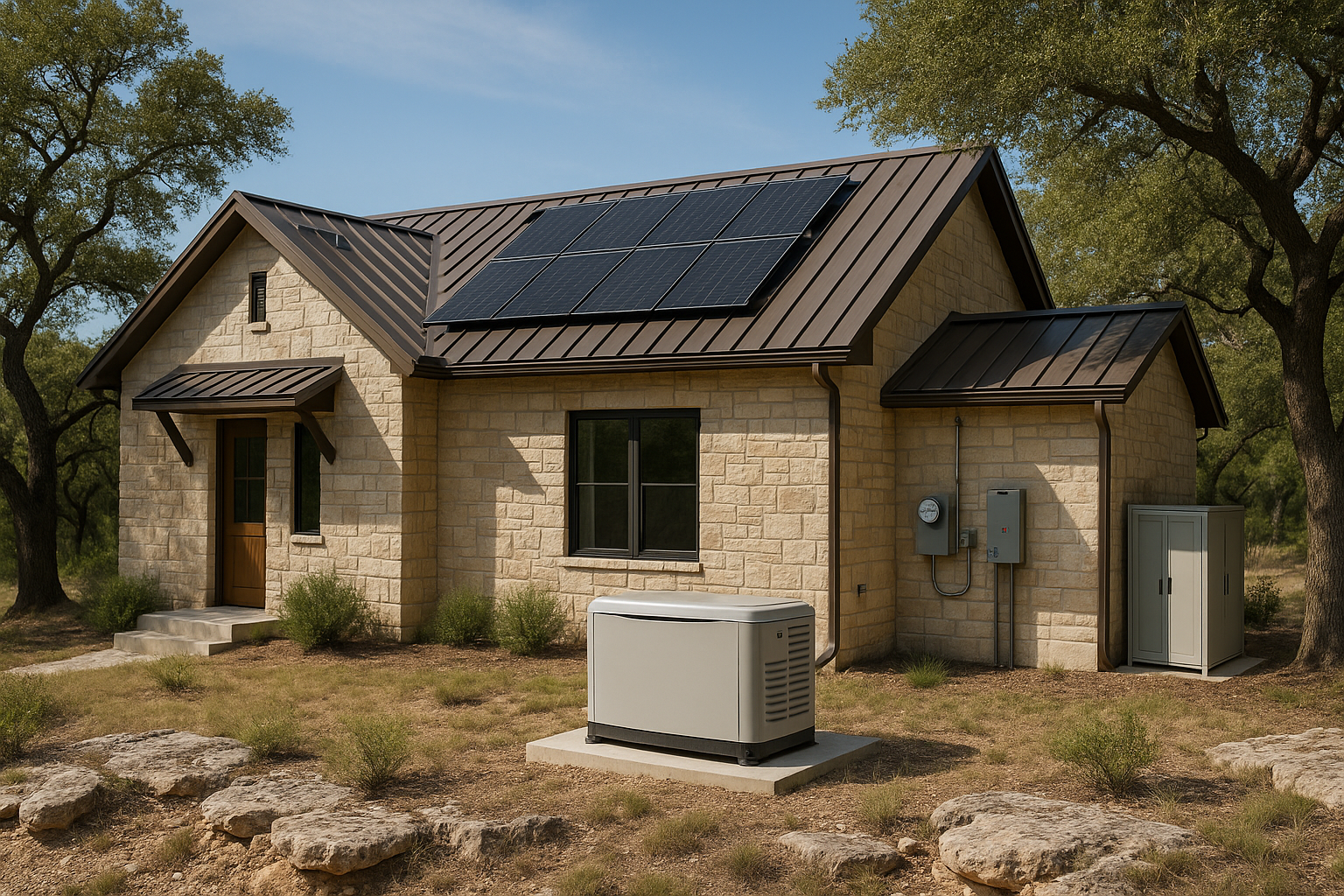Power Resilience for Rural Texas: Solar, Batteries, Generators


A pragmatic guide to designing solar, battery, and generator backup for rural Texas custom homes.
Start with loads: essential circuits, sizing, and power quality basics
Before choosing equipment, define exactly what you want to power when the grid is down. Start by listing essential loads—well pump, refrigerator/freezer, HVAC or a smaller mini-split zone, key lighting, internet/gate, garage door, and medical devices. Add up the running watts and account for surge (starting) watts for motors and compressors. A right-sized system avoids overspend while preventing nuisance trips. A quick homeowner-friendly walkthrough on sizing fundamentals is here: How to choose a generator (sizing basics). Quality matters as much as quantity. Sensitive electronics and variable-speed HVACs prefer clean power with stable frequency and voltage. Inverter generators and modern battery inverters produce high-quality sine wave output that protects equipment and reduces light flicker. Plan your backup architecture around a transfer switch or smart load panel that isolates selected circuits and prevents dangerous backfeed. Decide whether you need whole-home coverage or a critical-loads subpanel; critical loads often provide 80–90% of perceived comfort at a fraction of the cost. Document your essential loads early and share with your builder and electrician so rough-ins (conduit, exterior pads, ventilation) are baked into the plan.
Choosing your path: generator-only, solar + battery, or hybrid systems
Rural Texans have three common resilience paths: generator-only, solar + battery, or a hybrid that combines both. Generator-only is the classic, lower first-cost option. A properly sized standby generator (natural gas or propane) with an automatic transfer switch restores power in seconds; ensure fuel capacity supports multiple outage days and schedule quiet hours to respect neighbors and wildlife. For grid updates and distributed generation context, see ERCOT’s DG resource page at ERCOT distributed generation resource. Solar + battery provides silent backup, daily bill savings, and storm resilience without refueling—but batteries must be sized to your loads and expected outage duration. For a Texas-focused overview of home batteries and incentives, start with Texas home battery storage guide. Hybrid systems marry the best of both worlds: solar covers daytime loads and recharges batteries; if a storm lingers, a generator kicks in to top up batteries and run heavy equipment. When considering interconnection with your utility, check your local provider’s requirements (example overview of connecting generation equipment here: AEP Texas interconnection overview).
Permits, interconnection, fuel plans, and living with your system
Think holistically about permits, interconnection, siting, and fuel logistics. Many utilities require paperwork and a visible, lockable disconnect for solar/battery systems. Backup generators typically need slab pads, setbacks, ventilation clearances, and gas line sizing; coordinate early with your propane supplier on tank placement and trench paths. A policy backdrop can shift design constraints too; stay aware of state-level discussions and updates (e.g., Texas backup power package analysis), and keep an eye on grid-readiness conversations in industry news (see Utility Dive: ERCOT backup plan context). Day-to-day living with backup is straightforward when systems are commissioned well. Schedule load tests each season. If you choose solar + batteries, set charge targets before storms and ensure critical loads are on the protected panel. If generator-only, test automatic transfer monthly and keep spare filters and oil on hand. For practical outage-planning steps geared to Texas conditions, see Texas backup plan playbook. With thoughtful design and early coordination between builder, electrician, and fuel or solar providers, your Hill Country home can ride out outages with minimal disruption.
.png?width=400&height=133&name=TRUE%20STONE%20LOGO%20(1).png)